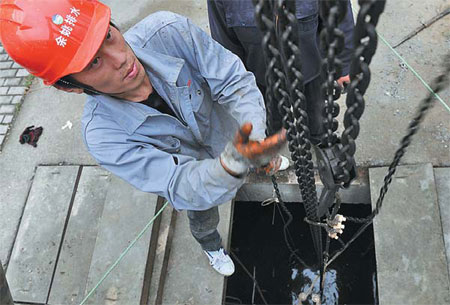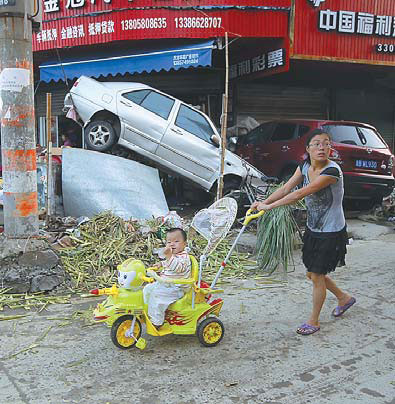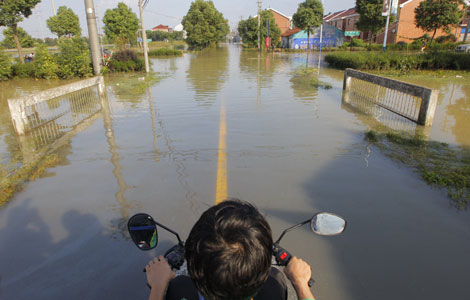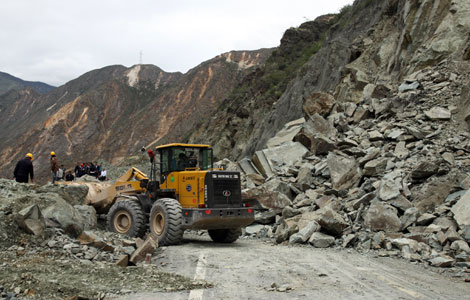Closing the floodgates to disaster
Updated: 2013-11-01 07:54
By Wang Zhenghua (China Daily)
|
|||||||||
For example, the United States has promoted a low-impact approach to land development that works with nature to manage stormwater as close to its location as possible by preserving, or sometimes even recreating, natural landscape features, such as lakes, which can absorb runoff, plus making roads and sidewalks more permeable so that water seeps through and enters the water table.
The approach is innovative in that the surplus water is regarded as a resource and not as waste and is usually channeled to irrigate areas of greenbelt and gardens. In addition, the process includes the use of bio-retention facilities such as rain gardens, vegetated rooftops, collection barrels and permeable pavements.
 |
|
A worker checks a drainage system in downtown Yuyao city. Chen Binrong / for China Daily |
However in China, the systems lag far behind. "Urban planning at the top level is defective," said Xie Yingxia, senior engineer at the China Academy of Urban Planning and Design.
He added that the core problem is that the drainage networks in Chinese cities are inadequate and lack a system to handle huge volumes of stormwater beyond the capabilities of the pipelines.
Experts have also pointed to the outdated design of drainage pipelines and the expansion of urban construction that has encroached on, and diminished, natural bodies of water that used to absorb storm runoff.
Meanwhile, there is a mismatch between the drainage capacities of pipelines and river courses in some cities, according to Liu Jun, a professor at Hohai University's Hydrology and Water Resources College. The poor alignment means that during periods of heavy rain, rivers are likely to experience "backflow", preventing water from the pipelines from entering the watercourse, he said.
The continuing reclamation of natural bodies of water in cities, such as rivers, lakes and wetlands, prevents them from helping to reduce the impact of rainstorms.
In Beijing, the process of increased urbanization has gradually resulted in the wetlands and natural bodies of water shrinking from 5 percent of the city's total area to just 2 percent. In Wuhan, Hubei province, the number of lakes is reported to have decreased sharply in recent decades, from more than 100 to 38.
When combined, these factors have resulted in cities becoming fragile in the event of heavy storms, and low-lying areas, underpasses and projects located underground are the hardest hit when the rains come. By the end of 2012, Shanghai alone had 30,000 underground projects, according to the Shanghai Water Engineering Design and Research Institute.
Drainage networks
Earlier this year, the State Council, China's cabinet, issued a notice urging cities to accelerate the construction of drainage networks to prevent or at least reduce flooding.
The notice said that cities should formulate detailed plans by the end of 2014, and that construction of fully functional systems should be completed within 10 years.
 |
|
Debris scattering around Yuyao in the wake of Typhoon Fitow. Gao Erqiang / China Daily |
Since 2011, several large cities, including Beijing, Shanghai, Wuhan and Guangzhou in Guangdong province, have announced multibillion-yuan projects to maintain and upgrade their drainage systems.
Despite these moves, experts have urged regional governments to step up their responses to severe weather and called for the use of state-of-the-art technology to improve the accuracy of weather forecasts in the event of impending storms.
Wang Xiang, deputy director of the Office of State Flood Control and Drought Relief Headquarters, said the inadequate emergency response to flash floods by local governments is a problem that requires urgent attention.
Even though China's major cities have established specific offices to coordinate flood control and drought relief efforts, lower level entities, such as communities, businesses and public organizations, are short of personnel, expertise and disaster relief materials, he said.
In addition, emergency response management involves multiple government agencies, including hydraulics, traffic, power, meteorological, construction and the urban management departments. However, although their duties sometimes overlap, their relief efforts are poorly coordinated: "Their duties should be clear and a coordination mechanism should be set up," he said.
Also, specific plans for emergencies, such as waterlogged urban areas, mudslides, traffic congestion, flooded underground projects and the failure of power and tap water supplies, are still not in place, although many cities have put forward contingency plans to deal with swollen rivers, said Wang. "Specific plans should be drawn up to deal with different kinds of flooding," he added.
Better planning urged
Wang Hao, an academician at the Chinese Academy of Engineering, said better urban planning is essential to prevent flooding in cities. "We need a systematic project to address the problem and prevent cities from becoming waterlogged," he said. "A proper network layout needs to be determined during the urban planning period, to dispose of stormwater as close to its location as possible."
He advised the construction of a major drainage system, consisting of tunnels, green land, natural bodies of water, retention facilities and roads to cope with the worst conditions in the coming 50 to 100 years.
"Stormwater runoff could then be carried through the drainage systems both above and below ground," he said. "Different regions should apply different methods, according to the prevailing conditions in their own areas."
Contact the author at wangzhenghua@chinadaily.com.cn

 Tan Dun premieres new work with Philadelphia Orchestra
Tan Dun premieres new work with Philadelphia Orchestra
 Two firms to debut in US at higher prices
Two firms to debut in US at higher prices
 Women fight to become China's next oceanauts
Women fight to become China's next oceanauts History under a new light
History under a new light
 Kung fu master becomes hit online
Kung fu master becomes hit online
 Color-blind love
Color-blind love
 Lenovo's new secret weapon: Hollywood star
Lenovo's new secret weapon: Hollywood star
 Brussels visit heralds closer trade ties for EU and China
Brussels visit heralds closer trade ties for EU and China
Most Viewed
Editor's Picks

|

|

|

|

|

|
Today's Top News
China ‘urges’ US to explain phone taps
US students compete in Chinese
The Chinese dream in ink
'Dangerous provocation' by Japan condemned
Freer RMB 'can answer US claims'
Two firms to debut in US at higher prices
Ministry opposes disclosure of WTO report
Obama calls for foreign investment
US Weekly

|

|







